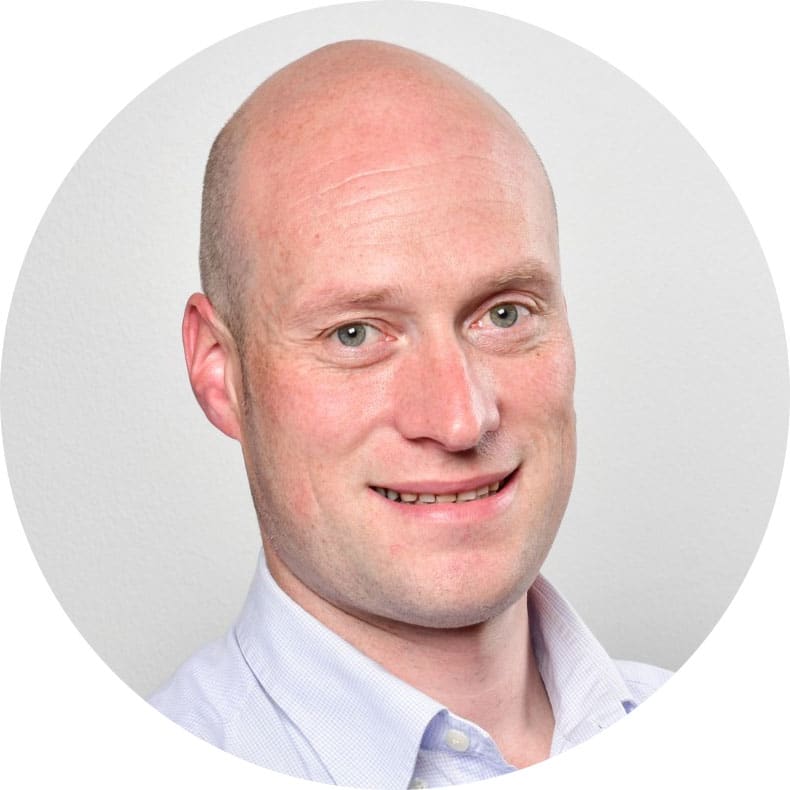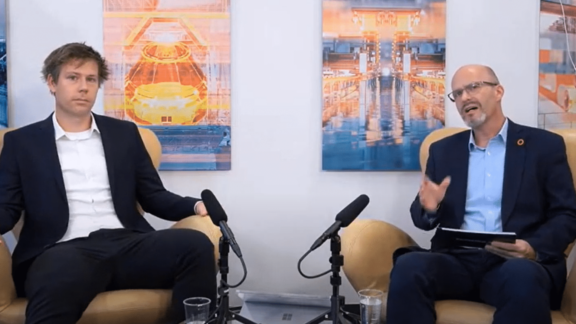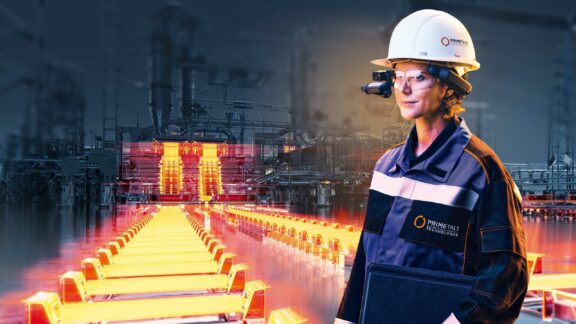In this session of Pioneers Talk, we sit down with plant-logistics expert Stefan Mühlbock to discuss how his simulations are helping steel producers to make the right investment decisions.
Pioneers Talk is the new video format of Primetals Technologies, focusing on informative and empowering interviews with experts in metals production and beyond. Topics extend to new advances in digitalization and automation, breakthroughs in green-production solutions, and success strategies for steel producers on all continents.

Interview with
Stefan Mühlböck
Stefan, I have heard that your team has done quite a number of logistics simulation studies and that your work is in high demand. Why are producers asking you to do these studies, and what do they expect from them?
Mühlböck: Well, to realize your plant’s full potential can be very complicated. On the one side a detailed knowledge of the complex interdependencies of processing equipment and transportation system is required. But on the other side the simulation of complex plant logistics and its material flow is an excellent method of uncovering hidden bottlenecks.
Okay, so a bottleneck is an area in the production chain where an aggregate is not performing good enough for any successive aggregates to be able to work at their full capacity? Is that sort of what you mean?
Mühlböck: Yeah, exactly yes.
So, you find these bottlenecks in the studies?
Mühlböck: Yeah, this is the main task of our investigations to find out bottlenecks, hidden bottlenecks, which are not easy to find. But with our simulation we have an excellent method to find such bottlenecks, and this is what our customer is expecting from us.
That sounds quite complicated and with the steel plant being so large and complexity being so high do you cover that entire steel plant? Do you just cover a tiny section of the steel plant with the studies? What are you including?
Mühlböck: Yes, our major expertise is the production scheduling and the simulation of the logistical processes inside a melt shop. In our simulations we take care of the moving teeming ladles with transportation means like ladle transfer cars or cranes in the right way through the melt shop from the primary steelmaking to the secondary steelmaking and later to the continuous casting machines; and in the right way in this context means that the ladle has to be at the scheduled position exactly at the scheduled time.
Stefan just a question for maybe some people in the audience. What is a teeming ladle? Is it different from regular ladles or is there a special ladle?
Mühlböck: Indeed, it is a special ladle. It’s a ladle which is circulating inside a melt shop with liquid steel in it coming from the primary steel making aggregate like a BF converter or electric arc furnace (EAF); and then going via the secondary steel making aggregates to the continuous casting machines and then through the casting process.
It sounds intriguing. It also sounds very, well, very detail-oriented work, very tedious work as well and I know how busy you always are; with complexity again being so high how do you go about creating the studies? Do you have a systematic approach? Do you have a step-by-step process by which you get to your results?
Mühlböck: Yes, it’s a step-by-step approach. At the beginning of each investigation there is an on-site fact-finding in order to be able to obtain a general overview about the actual situation on-site
That essentially means you travel there? You take your magnifying glass and visit the steel producer and inspect the site? And then what happens?
Mühlböck: Afterwards, a realistic steel plant production schedule is created, in other words a simulation model is set up. Information like processing times, production routes, and the product mix and the corresponding quantities are combined to create one schedule of all units from primary steelmaking to continuous casting machines.
It’s a ton of data. Are there additional steps after that?
Mühlböck: After the creation of the production schedule the first production bottlenecks can be already identified. An example can be that the treatment on a ladle furnace takes too long and then the next step is to check the visibility of the production schedule. As a part of the simulation, it is checked if enough capacity of the transportation means is available. If the simulation shows that the ladles are too late at the scheduled position and any delays occur some modifications are required. For example, it then can be considered to operate an additional crane.
Do I understand this correctly, first you travel there. Second step, you create what’s probably a giant spreadsheet with a ton of data in there where you create the perfect production plan. Then you look at the logistics setup of the steel producer and you determine whether what you came up with in terms of the plan is executable with the logistics they have?
Mühlböck: Exactly, yes.
And is there a fourth step?
Mühlböck: Yeah, it’s a nice three-dimensional animation of our simulation where the ladles can be observed on their way through the meltshop.
So, this is sort of the proof that you haven’t just dreamed up your results, but you can demonstrate them with an animation video. When you present steel producers with your findings with the video with your analysis of the logistics situation, I could imagine them going aha; this aha moment, realizing that you just showed them something that they hadn’t thought of, a positive surprise, something that will be of benefit to them. Is that the case and can you if so, can you give me an example of a time when this happened?
Mühlböck: Yes, indeed. Sometimes there are findings which our customers did not have in mind. In one study, a gradual transition from the classical BOF steelmaking towards hybrid steelmaking was planned to be realized and of course this transformation has an impact on the material flow inside the melt shop. In the run-up to this study our customer already had a very detailed and concrete idea for the transportation route of hot metal through the melt shop, but during the proof of concept it turns out that this special transportation route was not feasible. It wouldn’t have worked because the transportation system was completely overloaded in for this concept.
In the steps that we established earlier that would have been step three probably, so looking at the logistics and you found it’s not going work okay and so did you approach the producer, and did you only say not going to work or did you come up with an alternative solution to make it work?
Mühlböck: Together with our customer we developed a new different route which was later then proven by the simulation model and which delivers acceptable results for our customers.
That sounds much better than just acceptable. Do you have another example?
Mühlböck: There’s a second study of a big integrated plant where the customer’s focus mainly was on the BOF and the corresponding increase of productivity. The main finding of this study was that the bottleneck isn’t just the BOF converter. After the considered reduction of the tap-to-tap time of this converter, it turns out that the bottleneck was shifted from the BOF side to the secondary metallurgy.
So, they had another problem elsewhere that would have appeared had they gone through with the modification without consulting you and by consulting you they were able to anticipate this additional challenge early on. Did you also fix this problem?
Mühlböck: As a result of the detailed investigation the simulation shows that the target production capacity is only achievable with an additional twin ladle furnace in operation
So, you provided the advice to acquire that and change the production process accordingly?
Mühlböck: Yeah.
That’s great. With all these competences that your studies include and feature and also require in doing them it seems like there’s a great future ahead for your studies, but I also feel like the scope might even get larger as time progresses because the area you’re working in is very dynamic. What kind of future are you seeing for these studies? Will it be more of the same or will it change somewhat?
Mühlböck: It often turns out that steel producers are operating their plants on a very high level and they almost hit their production limit of their plans
You mean in terms of capacity they’re already as good as they can be most of the time?
Mühlböck: Yes. But I think in the future the steel producers will be confronted with a different kind of challenge like environmental regulations like CO2 regulations and therefore it becomes more and more attractive to operate your plant as a hybrid steelmaking plant.
Yes. But I think in the future the steel producers will be confronted with a different kind of challenge like environmental regulations like CO2 regulations and therefore it becomes more and more attractive to operate your plant as a hybrid steelmaking plant.
Mühlböck: In a hybrid steelmaking plant one or more electric arc furnaces are operated side by side with a BOF converter
So, you have part integrated production route part electric steelmaking route?
Mühlböck: Exactly. This is what we understand by hybrid steelmaking
So, the idea is to help producers over time reduce their carbon footprint by changing their production route in a smart way and your studies will probably give them inspiration and ideas how that can be achieved?
Mühlböck: Exactly.
That sounds like a great direction, Stefan, and it also sounds like we’ve come to the end of today’s Pioneers Talk. Thanks very much for being with us today. Thanks to our viewers for watching this video and we’ll be back very shortly with the next Pioneers Talk session.
Mühlböck: Thank you.
Stefan Mühlböck
Stefan Mühlböck is a senior expert in plant logistics at Primetals Technologies. He holds a degree in industrial mathematics with Johannes Kepler University of Linz, Austria, and likes to use his knowledge to understand and solve difficult problems—the higher the complexity, the better. His fascination with the facet-rich interactions of the many aggregates in a steel plant led Stefan to what he does today: solve super-complex problems for steel producers who want to optimize their plant logistics.
Dr. Tom Widter
Tom Widter joined Primetals Technologies in 2016 and now works in the Marketing and Communications department. He is Editor-in-Chief of Metals Magazine, the company’s customer magazine, and co-host of “Pioneers Talk”. Tom cares deeply about didactics, style, branding, the future of metals, personal growth, and the Oxford comma.


